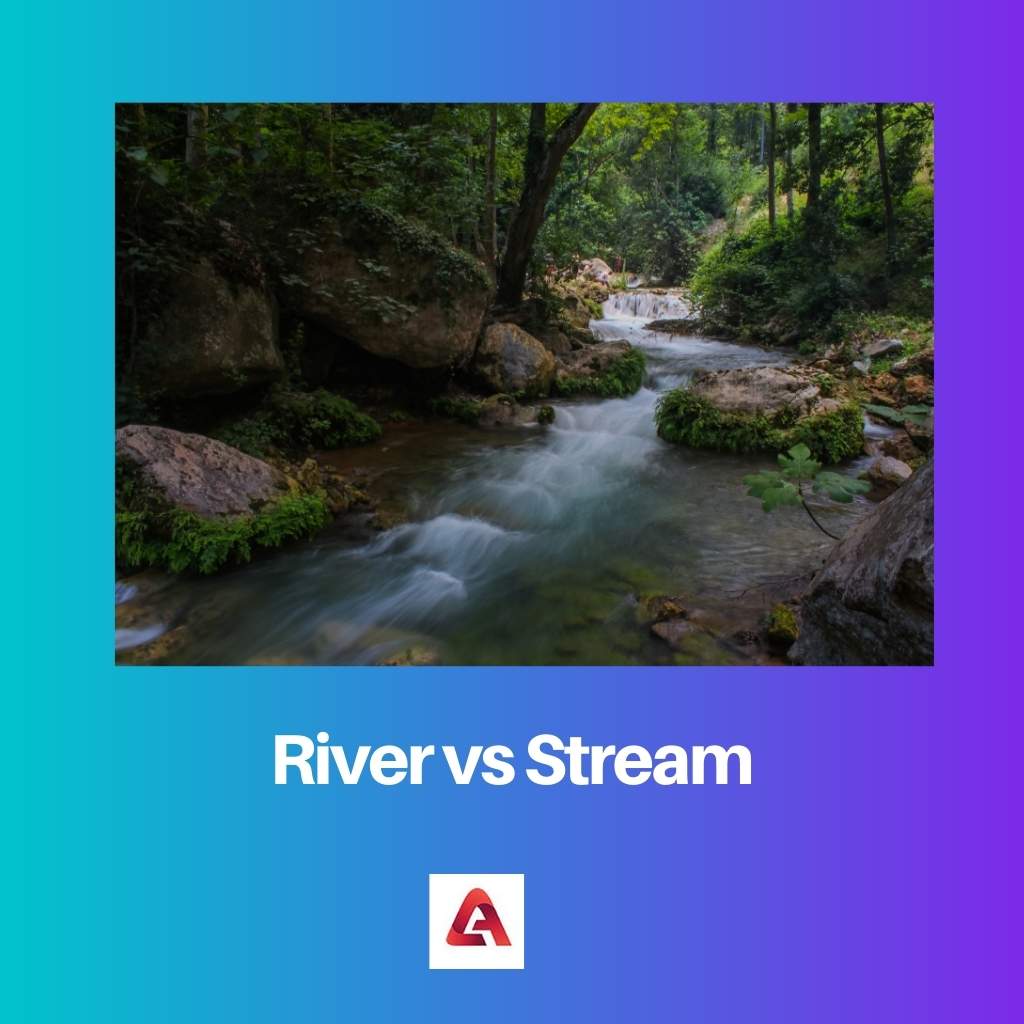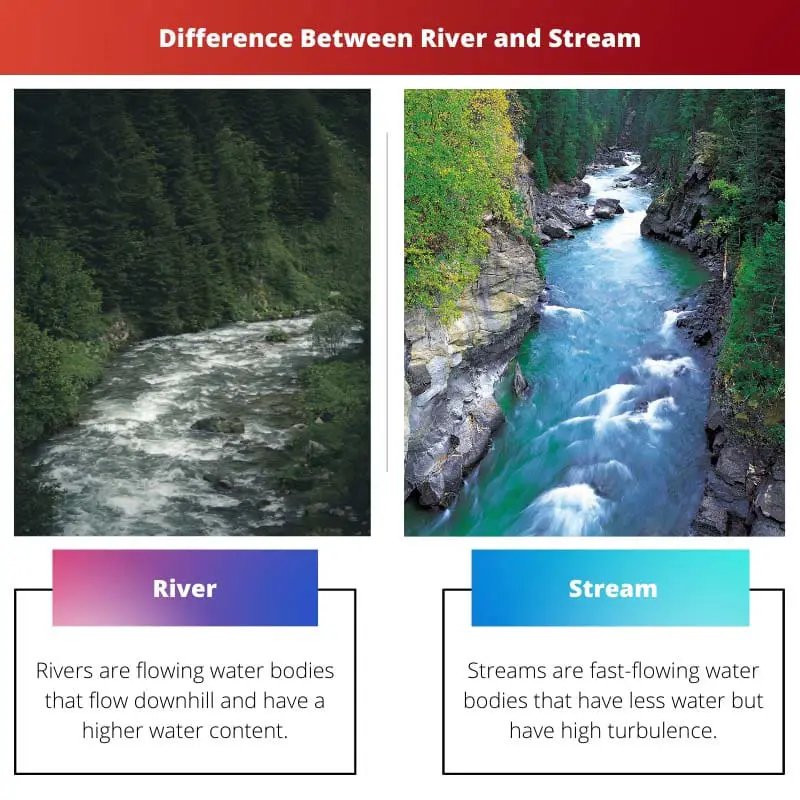Fast-flowing water bodies are one the most pleasant and soothing sceneries. Babbling brooks, serenely flowing rivers, beautiful streams, the sight of these water bodies has a kind of soothing effect on the mind. They help us calm ourselves by putting a stopper to that influx of thought that constantly bothers us.
Key Takeaways
- Rivers are larger bodies of water that flow into oceans, while streams are smaller bodies of water that flow into rivers or other streams.
- Rivers are deeper and wider than streams and can support larger aquatic life, such as fish and amphibians.
- Streams are more susceptible to changes in weather and can dry up during droughts, while rivers have a more consistent flow.
River vs Stream
The difference between Rivers and Streams is that rivers are large water bodies that are made up of numerous streams that have flown from different points and have met and combined to form a river. Streams are small water bodies that flow by themselves and originate from melting glaciers or water coming down from mountains.

Rivers don’t originate by themselves, as there has to be a source for a river. This source could be anything, from melting ice caps or water flowing from atop a mountain.
Most of the time, rivers originate in the form of small streams that have flown down by themselves from different places and have combined or met at a point during the flow to form the river.
Streams are small water bodies that flow by themselves. They do not contain much water and flow rapidly. Streams originate from melting glaciers or icecaps from the top of mountains.
The water melting from the icecaps falls in the form of waterfalls in different parts of the mountain, and the water flowing from these waterfalls forms streams. Multiple streams combine to form a river.
Comparison Table
| Parameters of Comparison | Rivers | Streams |
|---|---|---|
| Definition | Rivers are flowing water bodies that flow downhill and have a higher water content | Streams are fast-flowing water bodies that have less water but have high turbulence |
| Origin | Rivers originate from the confluence of many streams flowing from different parts | Streams originate from the melting of icecaps or surfacing of groundwater that flow in the same direction |
| Convergence | All the rivers ultimately flow into the sea | Many streams meet and combine to form a river |
| Water content | Rivers are huge sources of water | Streams contain small quantities of water |
| Turbulence | River speeds vary from 0.0 to 3.1 m/s. The speed of the river depends upon the general slope of the land, tide, the roughness of the channel, etc. | Streams are fast-flowing water bodies. As they constitute surface water, they have a high flow speed |
What is River?
Rivers are flowing water bodies that contain huge amounts of water. Rivers are naturally flowing watercourses, and due to their constant flow, they contain freshwater. Rivers are the primary sources of seas and oceans.
Rivers originate from the tops of mountains. Most mountain peaks have a cold atmosphere, leading to the formation of ice. The ice on top of mountains melts, and the water dripping from the icy mountain tops forms streams.
These streams flow down the mountain and meet at a point to combine their flow and form a river. The river is thus a collection of many small streams that have come down from mountain tops or streams that have formed at the bottom of a waterfall.
Due to the constant flow of a river, the formation of algae or other contaminants is less. Hence most rivers contain freshwater, which is water containing about 1000 or less ppm of dissolved salts.
Although due to external and manmade pollutants, the quantity of river pollution has increased in the last 10 decades. Rivers are the primary sources of seas and oceans, as all rivers flow and converge into oceans. Rivers are flowing sources of water, although the flow speed highly varies for different rivers.
Generally, the flow speed varies from 0.0 to 3.1m/s, and it mainly depends upon the slope of the land, tides, and channel roughness.

What is Stream?
Streams are fast-flowing water bodies that do not contain a huge quantity of water but have high turbulence. Streams consist of only surface water, and thus, the volume of the flow is very less.
Due to a low volume, streams are fast-flowing water bodies. Streams originate from the melting glacier waters or water flowing from the melting of ice on top of a mountain.
This melted water flows down in the form of small water bodies that later converge to form a river. Thus, small rivers are also sometimes called streams. Streams are also formed from the surfacing of groundwater.
Groundwater flows upward due to the pressure underneath and seeps through cracks in the ground. This seeping water begins to flow due to a constant influx of water from the ground, forming a stream.
Rivers originate from streams. The streams flowing from mountain tops flow in a unidirectional manner. As the general direction of all flowing water bodies is downward, streams are constantly in the downward direction until a point of convergence is reached.
At the point of convergence, at the bottom of a waterfall, all the streams meet and combine to form a river. The direction of the river is first in the direction of the flow, then along the slope of the land.

Main Differences Between River and Stream
- Rivers are flowing water bodies that have downhill water flow and contain huge quantities of water. Streams are small water bodies that originate from the melting of ice on mountaintops.
- Rivers originate from the meeting of many streams that have a unidirectional flow. Streams originate due to the melting of icy tops of mountains or due to the surfacing of underground water.
- Rivers are the main source of seas and oceans, and all rivers ultimately flow into the sea. Many streams that are flowing along the same general direction meet and combine to form a river.
- Rivers are the biggest sources of fresh water. Streams are small sources of water as they are formed due to the melting of ice.
- The speed of rivers varies a lot. Streams have high turbulence.

- https://books.google.com/books?hl=en&lr=&id=UNv_J3cyL24C&oi=fnd&pg=PR5&dq=rivers&ots=6cxVSLI0Aa&sig=7C2yqgI8PxzzTWadrWBqlPFHw3Q
- https://www.sciencedirect.com/science/article/pii/0341816294900019
- https://link.springer.com/chapter/10.1007/978-90-481-9088-1_2
- https://books.google.com/books?hl=en&lr=&id=FZLVrauq0ZMC&oi=fnd&pg=PA1&dq=rivers+streams&ots=JsixXJVIpE&sig=gD1sjk3A-9fqFIOxF-DeZ3UHvMk

The details about the formation of rivers and streams are intriguing. I’ve gained a better understanding of the primary sources of freshwater.
The in-depth information provides an insightful view of the ecosystem and freshwater sources.
Yes, it’s fascinating to learn about the natural origins of these water bodies.
The thorough explanations about rivers and streams have deepened my comprehension of these water bodies’ significance. The discussion about their water sources and formation processes has been enlightening.
I completely agree! The details have provided substantial insights into these fascinating natural wonders.
Indeed, the comprehensive coverage of rivers and streams has been hugely educational.
The details provided about the formation of streams and their characteristics have been truly enlightening. It’s intriguing to understand their contribution to water sources.
The information about streams has certainly deepened my understanding of water bodies’ diverse nature.
Absolutely, the insights into stream formation and water flow are captivating.
The distinctions drawn between river speeds and stream flow speeds have been enlightening. The geological factors affecting the flow speeds are particularly fascinating.
Absolutely, the impact of geological factors on water flow provides valuable insight into the dynamics of rivers and streams.
The distinction drawn between rivers and streams has been very informative. The details about their water content and flow speeds are fascinating.
Absolutely, understanding the differences in their qualities is truly captivating.
The comprehensive explanation about river origins and navigation to the oceans has been very informative. The distinctions between rivers and streams are much clearer now.
I agree, it’s amazing to comprehend nature’s processes in creating these water bodies.
I have always been fascinated by the difference between rivers and streams. It’s interesting to learn of their distinctions and how they both contribute to our ecosystem.
I agree! It’s incredible to learn about the different processes that contribute to the formation of these water bodies.
The information about streams has opened up new perspectives about these water bodies. It’s been an intriguing read.
Absolutely, this in-depth coverage of streams is truly captivating.
The explanations about the differences between rivers and streams have been insightful. The discussion about their water content and turbulence has been particularly interesting.
Indeed, the details about their water content and qualities provide a thorough understanding of rivers and streams.
The comparison table provided is quite helpful in understanding the distinctions between rivers and streams. It’s fascinating to learn about their origins and convergence.
Absolutely, the convergence of streams to form rivers is a remarkable natural process.